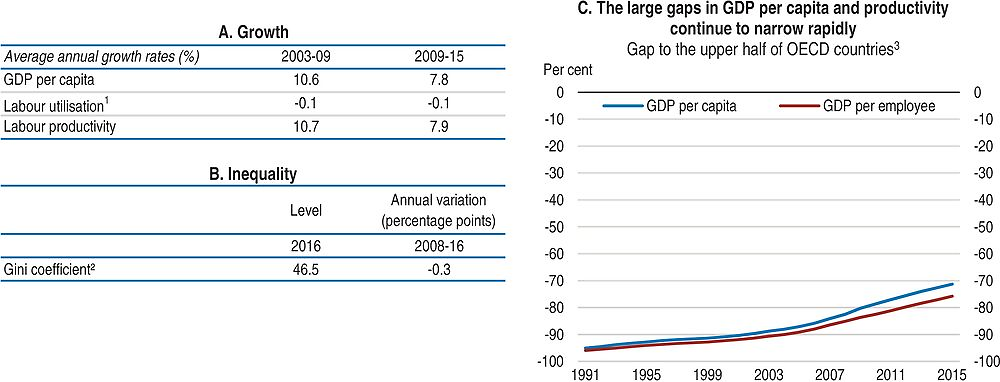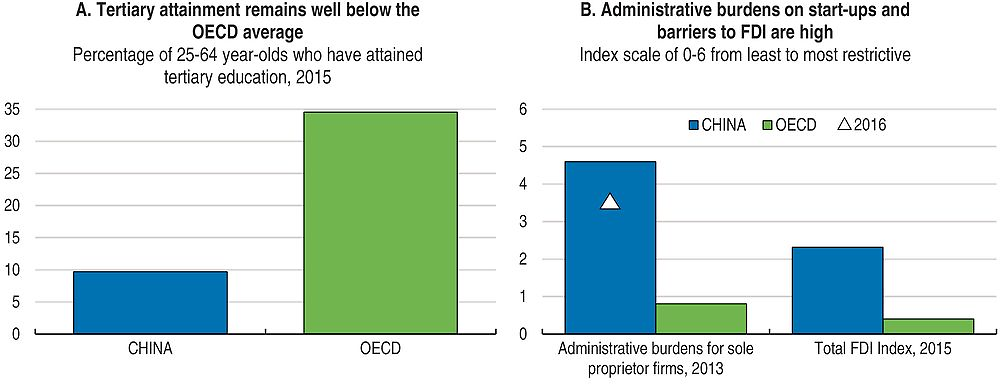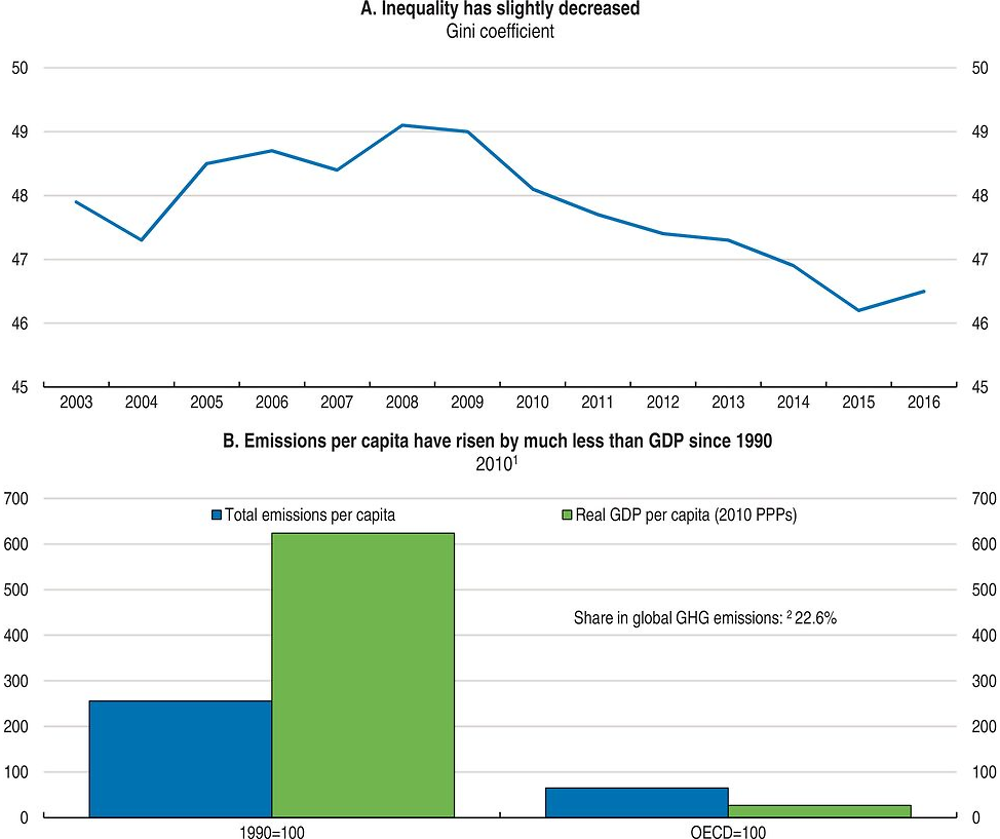China
-
GDP per capita continued to catch up with that of the upper half of OECD, though the New Normal – which puts more emphasis on the quality of growth – implies a slower catch-up. The income gap reflects lower output per worker as participation rates are above those in OECD countries.
-
Income inequality as measured by the Gini for disposable income trended down after 2008 as the middle class expanded but remains well above the OECD average. Moreover, the richest quintile of the population holds a higher multiple of the poorest quintile’s income than in OECD countries. Furthermore, the gap between urban and rural incomes has been narrowing in recent years.
-
Progress is apparent in all key priority areas identified in Going for Growth 2015. In the spirit of allowing the market to play a greater role in allocating resources, price regulation at the central and sub-national levels has been substantially curtailed. Thus, reducing state involvement in business operations is no longer considered top priority. Administrative procedures to set up firms have been simplified and the licensing system has been revamped. Interest rates have been formally liberalised.
-
In line with recent reforms introducing market mechanisms in various areas, the licensing and registration system should be streamlined further. Implicit guarantees should be phased out and the rule of law enhanced to create a more level playing field for all enterprises, which would lead to efficiency gains. A minimum standard of public services should be provided all over the country to lay the ground for more equal opportunities and reduce income inequalities. Abolishing the household registration system would promote social inclusion and deliver further productivity gains.
-
The commitments to curb GHG emissions towards the goal of COP21 need to be met and the cost of polluting to be raised sufficiently for polluters to reduce emissions under the national cap-and-trade carbon emissions system to be rolled out from 2017. The sanctions for violations of environmental laws and regulations should be sufficiently severe to act as an effective deterrent.

1. Labour utilisation is defined as the ratio of total employment over population.
2. The Gini index measures the extent to which the distribution of disposable income among households deviates from perfect equal distribution. A value of zero represents perfect equality and a value of 100 extreme inequality.
3. Percentage gap with respect to the weighted average using population weights of the highest 17 OECD countries in terms of GDP per capita and GDP per employee (in constant 2010 PPPs).
Source: World Bank, World Development Indicators (WDI) Database; China Ministry of Human Resources and Social Security; National Bureau of Statistics of China.

Source: Panel A: OECD, Education at a Glance 2016: OECD Indicators; Panel B: OECD, FDI Regulatory Restrictiveness Index and Product Market Regulation Databases.
Going for Growth 2017 priorities
*Further reduce administrative burden on start-ups and encourage private entry.*1 Administrative simplification reforms in the past couple of years have substantially reduced the burden on firms and individuals, increasing overall efficiency, but there is still ample room to advance reforms further. Entry barriers restrict competition in a number of industries.
Recommendations: Further streamline the system governing licenses and fees to realise further efficiency gains. Move towards a “one-stop-shop” model of business registration. Ensure country-wide implementation of reform measures. Open up more sectors to private and foreign entry to ensure efficiency-enhancing competition.
Ensure a better match between skills available and those demanded in the market. Tertiary graduation rates have increased in recent years but are still relatively low. Moreover, many graduates do not appear to have the skills required by the labour market, making it difficult for them to find a job. Fast-track training courses help obtaining various licenses, but the lack of in-depth knowledge of the field and of sufficient practice endanger the quality and safety of goods or services provided.
Actions taken: Training programmes focusing on migrant workers and urban residents with a low degree of employability have been set up from 2015. Employment agencies are now better regulated. Setting up vocational schools with foreign capital participation has been made easier.
Recommendations: Improve the matching between the skills acquired through the tertiary education system and those sought by the labour market: introduce new programmes and review curricula, textbooks as well as criteria for establishing the number of students that can be admitted to existing programmes. Make vocational education more attractive at all levels by hiring qualified teachers and establishing a good reputation for such programmes. Streamline licensing procedures for various qualifications and ensure minimum standards.
Strike a better balance between liberalisation and regulation in financial markets. Financial liberalisation brought to life a number of market players that are not subject to the same extent of regulation as traditional financial market participants.
Actions taken: Interest rates have formally been liberalised, with the exception of some policy rates. A deposit insurance system has been launched and the loan-to-deposit ratio regulation abolished, allowing smaller banks with a narrower deposit base to lend more. Internet finance regulation has been strengthened in 2015, though illegal fund-raising activities and defaults by person-to-person financial service providers have become widespread, prompting tightening of regulation in August 2016. Sub-national debt issuance is now regulated, but local government investment vehicles have been allowed to borrow again since 2015.
Recommendations: Remove implicit state guarantees to public entities to enhance risk pricing by financial markets. Enhance financial literacy through financial education from an early age.
Reduce barriers to labour mobility and strengthen social security and public service provision. Individual opportunity is largely determined by whether one is born in a rural or urban area with the respective registration system, curtailing labour mobility and leading to persistent income inequalities. Social security coverage and the quality of public services differ significantly between urban and rural areas.
Actions taken: Permanent residence cards have been introduced in a number of cities, but still a minority. In the largest cities it is still not common for migrants to get public education for their children and health insurance coverage for their families. Unregistered people who are otherwise eligible for a residential permit or hukou from 2016 can legalise their status.
Recommendations: Ensure equal education for all, regardless of registration status. Unify healthcare insurance at the national level so that services can be obtained country-wide. Establish a minimum standard of public services all over the country to avoid overcrowding in the largest cities.
Enhance the rule of law. Non-compliance with laws and regulations is widespread and a lack of transparency in many aspects of business provides room for discretionary decisions. Scarcity of and queuing for certain public services creates lucrative opportunities for arbitrage seekers, who obtain and re-sell access to those who pay most, but at the cost of depriving the less wealthy from access.
Actions taken: Business operations have become more transparent as the annual review of enterprises has been replaced by an annual disclosure of enterprise reports. As part of strengthening the judicial system, Shenzhen has started a pilot reform separating the career streams of judges and prosecutors in December 2014.
Recommendations: Make annual enterprise reports publicly available to reduce the scope for misleading advertising and fraud. Stiffen sanctions for forging documents, violations of disclosure requirements and other unlawful business conduct.

1. Total GHG emissions in CO2 equivalents from the International Energy Agency (IEA) database. This data conform to UNFCCC GHG emission calculations but are not directly comparable to data for Annex I countries due to definitional issues. The OECD average is calculated according to the same definition.
2. Share in world GHG emissions is calculated using International Energy Agency (IEA) 2010 data.
Source: Panel A: China National Bureau of Statistics; Panel B: OECD, National Accounts and Energy (IEA) Databases, United Nations Framework Convention on Climate Change (UNFCCC) Database.
Note
← 1. New policy priorities identified in Going for Growth 2017 (with respect to Going for Growth 2015) are preceded and followed by an “*”.
